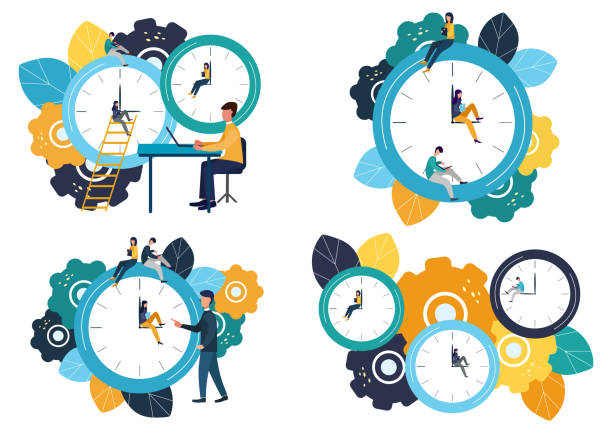
Your peak productivity hours refer to the period of the day when you are most productive. It is the time when you are most focused on your tasks at hand. It is linked to higher output and productivity if identified and maximized.
Unfortunately, most people have not identified their peak productivity period of the day, talkless of maximizing it. In this article, you will learn everything you need to know about peak productivity hours, and how to identify and maximize it for more productivity.
The Concept of Peak Productivity Period
The idea of a round-the-clock working schedule and 9-5 jobs has been for a while since the early 20th century in the United States. This arrangement only takes into consideration the number of hours a worker must work for optimal output in the firm or organisation.
In the 20th century, various labour unions in the United States started to push back against the rigorous 12-14 hour workdays that many employers required from their employees.
By 1938, President Franklin Roosevelt signed the Fair Labour Standards Act which prescribed a certain number of hours worked each day, amounting to a maximum of 40 hours per week. This required that workers who are made to stretch beyond that number would receive overtime pay per extra hour spent.
That was where “9-5” originated, with the assumption that the peak productivity hours of most workers for maximum productivity will fall within that period.
The Peak Productivity Period Is Subjective
The standard 9-5 work schedule is not optimal for everyone, even though most people have their highest cognitive abilities between 8 am to 2 pm. It’s therefore important you identify your peak productivity hours throughout the day and maximize it for organizational or personal productivity.
“The early bed gets the worm”, so the saying goes. But what happens to those who identify as the night owl – those people who are more focused and productive at night?
Whether you know it or not, there are many people whose peak productivity period is different from what you might agree with. Everyone has peak productivity hours and it is important that you identify yours to maximize productivity.
Peak Productivity Hours and the Ultradian Rhythm
Generally, the ultradian rhythm is a cyclical or recurrent period repeated throughout a 24-hour period of the day. It is different from the circadian rhythms which have only one complete cycle throughout the day, and from the infradian rhythms such as the human menstrual cycle which have periods lasting longer than a day.
The ultradian rhythm as it relates to the peak productivity hours concepts describes that there are several periods of peak productivity and maximal focus occurring throughout the day, lasting for approximately 90 minutes each. These periods of peak productivity are followed by periods of reduced concentration.
How To Identify Your Peak Productivity Hours
What time do you feel most productive throughout the day? What time do you feel very uninterested in any mental activity? What time are you most focused and least distracted?
There is every chance you already have an idea of what these periods are. Only that you may not realise that this rhythm is something you could harness for better productivity. Here, you will learn how to concretely identify what your peak productivity hours are and how you can use them to your advantage.
1. Track your daily work performance
If there is any way to concretely identify your hours of peak productivity, it is by tracking how you perform throughout the day. Some people kick off productivity as soon as they wake up from bed. Others would experience the same a few hours later.
Keeping track of your daily work performance over time will help you understand what periods of the day you are most productive. To do this, keep a journal of everything that happens throughout your day. Do this retrospectively at the end of the day, recording everything you did from when you woke up to when you go back to bed.
You will find that at certain periods of the day, you achieved much less than at other times. Those periods when you achieved more tasks. Those are your peak performance periods.
Look out for the following parameters:
- When are you most awake?
- When do you accomplish results the most?
- When do you feel most lethargic and uninterested to work?
- When do you enjoy working the most?
These questions help you identify your most productive periods, otherwise referred to as peak productive hours.
2. Understand your own ultradian and circadian rhythm
As already mentioned, the ultradian rhythm is a cycle of periods of peak focus and heightened cognition throughout the day. It is said to occur every 90-120 minutes throughout the day. This means you experience 90-minute bouts of heightened productivity.
Each time you feel the inner drive to work, it signals that your body is ready to perform. Aim to continue working for about 90 to 120 minutes once you feel that inner performance drive.
3. Identify your midpoint
According to Daniel Pink in his book, “When: The Secrets of Perfect Timing”, identifying your midpoint can help you identify your peak productivity hours of the day. The midpoint is simply the middle hours between the time you sleep and the time you wake.
If you sleep at 11 pm and wakes up at 7 am, your midpoint will be 3 am. And if you sleep at 2 am and wake up at 10 am, your midpoint will be 6 am. So, how does this midpoint help in identifying your peak productivity periods?
Owl, Lark, or the Third Bird
According to Daniel, your midpoint defines everyone into three types of birds based on the concept of peak productivity time.
If your midpoint is after 5.30 am, you are an owl, a night person. It means you often go to bed past midnight or 1 am.
If your midpoint is 3.30 am, you are a lark, the morning bed, and you are a morning person.
If your midpoint is between 3.30 am and 5.30 am, Dan referred to you as the third bird. The world’s typical “9-5” work schedule is designed for this category of people.
If you are a morning bird or the third bird described by Daniel Pink, you are fortunate because over 80 per cent of the world’s population belongs to these categories and most jobs are designed in their favour. Only 20 per cent, however, are the morning people.
20 per cent of the world accounts for the night owls, the small minority that may need to adjust to the work schedules of the majority of birds.
Whether you are a morning bird, a night owl or the third bird, understanding this concept of peak productivity will equip you to take advantage of your inner productivity clock as you will see in the next sections.
4. Identify the factors that determine your peak productivity hours
The concept of peak productivity hours is not often a very static one. Several factors determine when your peak productivity hours fall into.
Of course, you have your inner productivity clock we talked about earlier, but several environmental factors play a role in determining when your peak productivity will be.
For example, your sleep duration and sleep cycle affect when your peak productivity will be. Long sleepers generally sleep for at least 9 hours, while short sleepers are satisfied with 6 hours of sleep. Sleep in itself is restorative and helps you refresh your body and brain systems for enhanced productivity.
It has also been found that cortisol is highest in the morning immediately after waking up. This stress hormone helps in enhancing performance and also gives resilience to deal with stress, and it has shown a positive relationship with sleep.
Adequate nutrition, rest, and a good state of the mind can also affect your peak productivity hours, such that even if your natural peak period is set at specific times, the lack of these factors can still dampen your productivity. As a rule, do your most important tasks during your peak hours and rest during your less productive hours.
How to Maximize your Peak Productivity Period
1. Schedule important tasks into your peak periods
Since you are more productive during your peak hours, you should schedule your most important tasks and tasking activities for this period. You require maximum concentration to achieve optimal results in these activities. It is therefore important to plan them for the period when you are laser-focused.
Cal Newport, a professor of Computer Science in the United States, describes this activity as “deep work”. According to him, deep work involves extended periods of highly focused work on important tasks. These tasks are effort-demanding and require much of your concentration.
When you engage in deep work, you essentially stay long enough on the job until your mental concentration crystallizes so well that the results become pretty obvious.
For example, you don’t expect to make significant progress within just 10 minutes of working on a song in your studio. The first few minutes will be used up in getting you prepared for the actual job. This is what deep work is all about.
Peak hours may come several times in a day (as you have seen in the ultradian rhythm phenomenon above). You can also create more peak hours as you will see shortly, but to maximize productivity, schedule important, tasking and deep-work sessions for this period when your energy level is highest.
You simply do not want to waste your most productive hours on things that are not important.
2. Establish a habitual pattern of productivity
After identifying your peak hours, you maximize efficiency by making it a habit. Habit are a result of consistent and regular repetitions, but once they are established, you find yourself engaging in them with minimal energy.
Establishing in habitual pattern of productivity by leveraging on your peak productivity hours will make your body to instinctively go with the flow. In time, your body will automatically know when your peak periods are approaching and you will routinely find yourself being productive during your peak hours.
It is possible you have not trained your body well enough to utilize your peak hours. You may have been wasting your peak hours on your work or study schedule, but now that you have identified when your peak hours are, begin rebuilding a new pattern centered around your productivity periods.
If going out for a morning jog, or taking a cup of morning coffee can get you more prepared for the day, this is a habit you should establish for more productivity.
3. Create more peak hours during the day
It’s hard to tell the exact number of peak hours in a day but this is influenced by a number of factors. If the factors are right, you can create more peak hours in your day.
Your peak hours are characterised by heightened productivity and mental focus. These are times when your body is at rest and you are in the best frame of mind for productivity. This translates that once you get the conditions right, you can create additional peak hours or resuscitate dying peak hours in your day.
Now, what are those conditions?
Again, adequate rest, sleep and nutrition have a powerful impact on your peak hours. Also, while office schedules can negatively impact your peak hours, most especially if you are not naturally a morning bird, you can maximize your available peak hours or create new ones if need be.
For example, after returning from work by, say 4 or 5, eat and then get adequate rest for a few minutes. You would have recharged significantly to engage in your personal or corporate assignments.
Personally, I would classify myself a night person because I found a way to maximize some hours of the night after a huge part of my day has been chunked off by busy schedules. This is a great way to create more peak hours.
4. Rest and sleep when you need to
You don’t always get the drive to work. It’s normal to feel exhausted sometimes, but what you do during these times determines how productive you will be when you enter your peak productivity period. If you refuse to rest enough when you need to, the exhaustion might spill over to your supposed peak hours, and can make you less efficient during those periods.
You can rest by seeing a movie, listening to your preferred music and songs, and so on.
Also, do everything possible to get an adequate night’s sleep for at least 6-8 hours every day. It doesn’t matter when you go to bed but you want to get enough sleep so as to avoid daytime sleepiness that may encroach into your peak hours during the day.
Leisure, rest, sleep and play are important in maximizing your peak productivity periods.
5. Set strategic goals during your peak periods
Schedule your most important and challenging tasks into your peak productivity periods because that’s when you are most prepared to handle them. however, your schedules and goals must be SMART. SMART is an acronym for Specific, Measurable, Attainable, Realistic, and Timely.
Because your productivity is at its peak during your peak productivity hours does not mean you should load the period with tasks that you cannot achieve. This might give you some feeling of discouragement.
SMART goals have the characteristics of being achievable, realistic and time-bound, unlike those that seem so overwhelming.
You should also eat the frog during your peak hours. Eat the frog is an idiom for the act of prioritizing your most difficult tasks. Start with your most dreaded tasks, then work your way down the line while your energy decreases correspondingly.
6. Rekindle your passion
Without passion, even the most energizing moments become useless to you. Without passion, you seem frustrated about everything. all you want to do is eat, sleep, and continually rest your brain.
Some tasks can be so daunting that they can frustrate you into losing your energy for carrying them out. You must always rekindle your passion for your projects, plans or tasks so that you can be able to willfully stand up to work when you truly feel like doing so.
Passion is the inner satisfaction and naturally drive to engage in a task or undergo a project. Passion is a product of inner desires and the need to achieve results that can change lives. If you develop enough passion for something and you are careful enough to sustain it, there are practically no circumstances that can hamper you.
7. Aim to further maximize efficiency
Working during your peak productivity hours already gives you a good level of efficiency and productivity, but what if you can further improve efficiency during your peak hours?
One way to improve your productive efficiency during your peak hours to group tasks together based on shared similarities. The more similar the tasks are, the better. An example involves processing paper works together at one time, after which you can move to do something else.
Once again, good rest, sleep and adequate sleep can help you maximize your peak-hour productivity. Creating a conducive environment also helps you achieve more efficiency when working during your peak productivity hours.
The fact that you are more focused strengthened to work, and motivated during your peak hours does not mean you should put yourself through unnecessary punishments when you can boost your productivity simply by working under the right conditions.
8. Avoid distractions as much as possible
You don’t want to entertain distractions during your peak periods. Shortly, your peak productivity hours will pass. It will be very regretful if you allowed distractions to take that precious time from you.
One way you can avoid distractions is to firmly say no to activities or people that could waste your precious peak hours. Your peak productivity hours are not the time to engage in frivolous conversations with friends. It is not the time to engage in leisure activities like watching the TV, playing, sleeping, etc.
During your time for rest, these activities can be relieving but they are time-wasters during your peak hours.
When you allow these time-wasters to steal your time, a popular defence mechanism we adopt is to procrastinate. You tell yourself you will do it later, without realizing that this is the best time to complete the task or to start it at least.
9. Maximize gap times
Gap times are those small blocks of time between major activities that are unused for anything significant. Examples are, the time you spend waiting for your turn in the queue, and the time you spend sitting in the back seat of the car during a long journey.
Some of these gap times coincide with your natural peak productivity hours and you can salvage them from being totally lost. Instead of standing all through the long queue without doing anything meaningful, convert this gap time to reading about your work or carrying out some tasks if the situation permits.
10. Review your previous week, give rewards, and improve!
The best way to check your productivity is by taking a retrospective look at your previous performance. You are going to analyse your performance against your goals and then against even prior performances.
When you review your previous week’s achievement, your aim is to find out how much you improved and how much more you need to do. Either way, never forget to reward yourself with some gift if you merited it. As simple as taking yourself out can be a much-needed extra motivation for the next phase of your productivity.
Frequently Asked Questions about Peak Periods
Does the early bird always get the worm?
You might have heard the idiom, “The early bird gets the worm”. This statement refers to someone who wakes up early in the morning and arrives at a stipulated place in good time. It also refers to the benefits you get when you arrive before other people.
“The early bird gets the worm” statement is strongly supported by the traditional “9-5” or “8-4” job model. It requires you to wake up early for work, but some people have peak hours outside that working period. That means they can be more productive at other hours.
Once you know that your peak hours is outside the 9-5, do all you can to salvage your peak hours for productive tasks even if it is something outside what your job requires.
Simply put, the early birds do not always get the worm, except if the bird is naturally supposed to wake up early.
Is using the internet during my peak period a distraction
The internet can be used for a myriad of things. It can be a distraction during your peak hours if you are using if for something entirely unrelated to your peak hour task.
Can I rest more after automating my tasks?
Task automation is highly recommended for every worker. Thankfully, several automation softwares have been created for enhanced productivity and more freedom. For example, the web tool, IFTTT can be used to automate social sharing actions for specific times, as well as other actions. These are just to mention but a few.
When should I stop working?
The idiom, “Keep your nose to the grindstone”, means you should continue working until you get things done, even when you are getting exhausted. There are times when endurance will be needed, such as times when you need to keep your nose to the grindstone but as soon as your productivity starts waning, stop working and get some rest.
According to researcher, Roy F. Baumeister, willpower is a limited resource that you can easily deplete through hard work. In his study, he gave chocolate chip cookies to two sets of students. In the first set, he allowed them to eat the cookies, but in the second set, he resisted eating the cookies.
After that, he gave the two groups similar math problems. The first set who ate the cookies did very well in the test, while the second set who had used up their willpower to resist eating the chocolate cookies simply gave up on the sight of the complexity of the math problems and did poorly.
Avoid using up your willpower on things that are not worth it. This means you should stop working when you are extremely and maximally exhausted.
Should I multitask during my peak hours?
We are all taught how to multitask to maximize our time. Multitasking is a great way to save time if done by someone who knows how to, but multitasking can be a distraction if you do not know how to handle different tasks simultaneously.
To stay focused during your peak periods, you might want to avoid multitasking unless you are sure that you can efficiently handle multitasking during those crucial periods.
Can working from home help me optimize my peak hours?
The simple answer is “Yes”. You can leverage working from home to optimize your peak hours. When you are working from home, there is no boss to dictate what you should or should not do, as long as you get the job done in the stipulated time. What this means it gives you the flexibility to work during your peak hours and rest when you no longer feel productive.
However, without self-discipline, working from home can turn out to become disadvantageous as the worker might not feel motivated to carry out their required duties.
Conclusion
After having known about your peak productivity hours, it becomes extremely important to guard that period jealously and to maximize your peak hours.
Learn to do the most demanding and/or important task during your peak hours. Rest and sleep adequately when you need to. And track your previous and current performance.
Before all of these, we must not forget the very first step, “Identify when your peak productivity periods are”; and then maximize them.

















